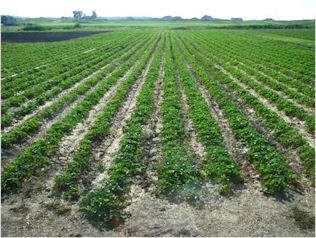Avoid Winter Injury of Strawberries Due to Dry Soil
Given the hot, dry weather we have experienced this past summer (and now fall), consideration needs to be given to providing adequate soil moisture conditions to strawberries as the plants prepare for winter. Strawberries require regular watering because of their shallow root systems.
Importance of Fall Irrigation
Risk of winter damage may increase when plants are under stress from lack of moisture. Plants should have access to a good level of moisture right up until mulching. The cold hardening process is mainly controlled by the shorter days and cooler temperatures and is not hastened by withholding moisture.
Normal autumn rainfall amounts should be taken into account to avoid over saturation of soils prior to covering.
Key times for irrigating strawberries include:
- establishment
- initiation of berry set
- maximum final enlargement of the fruit
- before signs of wilting occur (otherwise berry size is greatly reduced)
- after renovation of June bearers when fruit buds are forming
- fall, just prior to covering, to reduce risk of winter injury
Strawberry Shallow Root Systems

June bearers have 90% of their roots in the top 15 cm (6 in.) of soil, while day neutrals have 90% in the top 7 to 10 cm (3 to 4 in.). Both types of strawberries may have smaller root zones caused by winter injury or a narrowing of the rows during renovation.
The susceptibility to drought makes irrigation particularly effective for strawberry production. A 2.5 fold increase in yield has been recorded with some cultivars grown under irrigation versus non-irrigated strawberries.
It is most efficient to irrigate early in the day, when evaporation losses can be kept to a minimum. Straw mulch also greatly reduces evaporation from the soil.
Typical Strawberry Irrigation Requirements
Day neutral strawberries may require higher rates of irrigation or more careful monitoring of soil moisture levels because of their shallow root systems. Trickle irrigation on light soils with a black poly mulch may require application rates as high as 5 L/m2 (0.1 gal/sg. ft.) per day. Without mulch a rate of 37 L/m2 (0.75 gal./sq. ft.) per day should be sufficient. (Dale and Pritts).
To determine if soil moisture is sufficient, use this hand test method:
- Brush away the dry soil surface.
- Take a handful of the newly exposed soil and squeeze it lightly.
- If the soil ball breaks apart readily as you open your hand, the soil needs water.
For more details on this method see Appendix section (pp.85) of the Commercial Strawberry Production on the Prairies Guide.
Tensiometers provide a second option. The difficulty in using these devices is that the reading on the device varies with soil type. Tensiometers are better suited for use on sandy soils, where they monitor most of the available moisture range. In heavy soils, large amounts of available moisture occur outside the detection limits of the tensiometer. Avoid irrigating just prior to picking. Based on a two day picking interval, irrigate immediately after picking with 6 to 8 mm (1/4 to 1/3 in.) of water.
Take care to avoid excessive irrigation which can leach herbicides and nutrients out of the rooting zone. Too much moisture can diminish yields, reduce fruit quality and increase fruit rot development.
This article is a modified version sourced originally from the Irrigation section of the Commercial Strawberry Production on the Prairies Guide.
Resources
Irrigation Scheduling For Fruit Crops OMFRA Factsheet
Commercial Strawberry Production on the Prairies Guide
Dayneutral Strawberry Production Guide, Dr. Marvin Pritts and Dr. Adam Dale, 1989 http://hdl.handle.net/1813/3275

